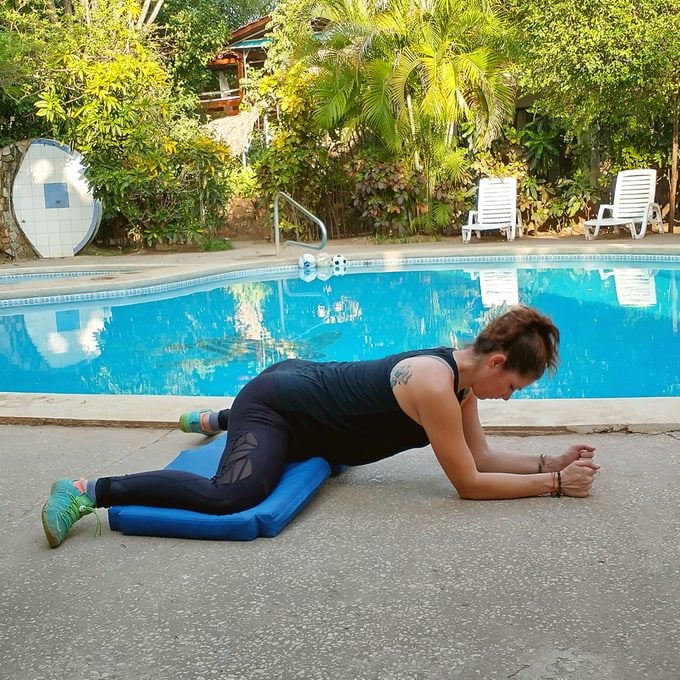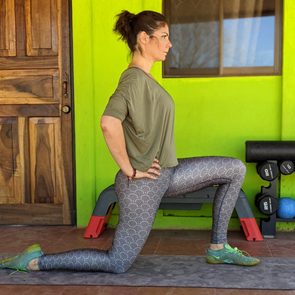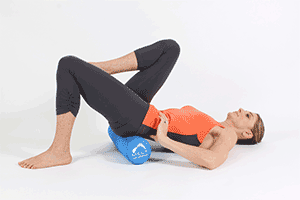How to Do a Frog Stretch Correctly—and Safely
Updated: Jun. 01, 2021
When your hips and low back are feeling tight, try adding this frog stretch—or a frog-pose modification—to your routine.
All about the frog stretch
Admittedly, there are some moves that are a little more awkward to do in public than other ones.
Consider the frog stretch or, as it’s termed in yoga, mandukasana. It places you face down, hips spread, legs wide on the ground. Potentially embarrassing? Sure.
But just because it looks a little awkward—not unlike a frog kicking its legs through the water—doesn’t mean you should skip it.
If you have tight hips and groin muscles, this easy yoga pose could offer serious relief for your tension and help you increase your side-to-side flexibility.
Benefits of doing a frog stretch
In yoga, the frog stretch is considered a hip opener.
If you spend a lot of time sitting at a desk or doing repetitive forward-backward leg movements like walking, jogging, or cycling, chances are your hip flexors and adductors (the groin muscles responsible for pulling your legs in toward your midline) are entirely too tight.
You need to balance things out with side-to-side exercises like jumping jacks, side slides, Rollerblading, or frog stretches.
Adding the frog stretch to your regular routine can help open up the hips, offering relief for tightness.
Done regularly, the stretch may even help strengthen your core and provide lower back pain relief. As it happens, low back pain often stems from tightness in the hips.
Who should—and shouldn’t—try this stretch
Generally speaking, the frog stretch is a safe exercise for most people.
That said, if you have an active injury or weakness of the knee, hip, or lower back, approach the stretch with the knowledge that it might not be a good fit for you.
If you’re pregnant, talk to your doctor about what movements or positions might be ill-advised.
For instance, if you have a lot of flexibility through your hips (which can increase with pregnancy hormones), you want to make sure you’re not placing any pressure on your growing belly to perform this move.
If you don’t have any known issues or pain, just pay attention to your body, move slowly, and don’t try to force your legs wider than feels safe and comfortable.
You’re looking to feel a light stretch in your groin and inner thighs, not outright pain.
What to know before doing the frog stretch
One thing to remember is that your knees are going to be supporting a lot of your body weight.
If balancing on your hands and knees tends to leave your knees feeling sore or sensitive, don’t shy away from using a rolled-up yoga mat or blankets to alleviate some of the pressure.
If you’re looking to increase hip mobility and flexibility, this stretch is best saved for after a workout or as part of an extended stretch session when your muscles are nice and warm.
“You can do the frog stretch any time but especially after a run or even if you’ve been sitting down all day,” says Erin James, a personal trainer, yoga instructor, and founder of Squay, a company that focuses on holistic living.
Static stretches are particularly helpful when it comes to maintaining or improving flexibility, but they’re less effective if your muscles are cold. Even a five- to 10-minute dynamic warm-up can help prepare your body to respond more effectively to static stretches like the frog stretch.
That said, James emphasizes that the frog stretch can also be used as a “comfort stretch” to ease tension in your body without warming up first.
You may find this is particularly helpful during your menstrual cycle or if you’re experiencing stress that you’re carrying in your hips or low back.

How to perform the frog stretch
The frog stretch is fairly straightforward and simple to perform as long as you’re listening to your body.
Start in a tabletop position on your hands and knees on a yoga mat, your wrists under your shoulders, your knees under your hips.
Remember, you can fold your yoga mat or add blankets to help take pressure off your knees if they’re sensitive.
Make sure your back is flat and your core is engaged—this is important throughout the entirety of the stretch. You don’t want your low back to sag or your chest to collapse between your shoulders.
Slowly move both knees out to the sides, your left knee moving left, your right knee moving right. You’ll continue edging your knees outward until you feel a nice stretch through your groin and inner thighs.
As you move your knees outward, rotate your ankles out so the inside of your feet are flat on the floor.
Depending on your flexibility, you can change your upper body positioning, lowering from your palm-supported position to an elbow-and-forearm-supported position. If you’re very flexible, you might even rest your chest on the ground.
Regardless of your upper-body position, keep your core tight and engaged and your back flat (not sagging) between your shoulders and hips.
When you feel a nice stretch, hold the position, breathing deeply, allowing your hips to continue opening if or when your body allows.
Maintain the frog stretch for 30 to 60 seconds. Repeat two more times.
(Keep these other easy groin stretches handy for healthy hips.)
After the stretch
James emphasizes that it’s important to move out of frog’s pose safely.
If you’re on your forearms, come back to a tabletop position on your palms, then walk your palms back toward your hips.
Bring your knees closer together, one at a time. When you’ve returned to the starting position, she suggests resting in child’s pose for about a minute to allow your body to recover.
Common mistakes
The most common mistake when doing the frog stretch is trying to force your knees wider than they naturally want to go. This could lead to a groin strain or injury, so when your body tells you “I can’t go further,” that’s your cue to stop.
It’s also very important to keep your core engaged. Not only will this prevent any potential low back problems, but it works as a modified plank position, strengthening the deep muscles of the core and low back to help maintain the position.
And while frogs may kick their legs out, extending their feet past their knees, humans should avoid it. Because of the pressure being exerted on your knees and ankles during the stretch, James says it’s important not to allow your heel to reach outside your knee line, which could cause more pressure and pain.
(Give the scorpion stretch a try to loosen up your hips and back.)
Frog stretch modification
If the frog stretch itself feels too intense, James suggests modifying it by making small adjustments to a child’s pose.
Move into child’s pose but widen your legs and don’t fold as far forward.
This helps keep your hips back, sitting closer to your heels, but also encourages your pelvis to open wider. Think of it almost as sitting like a frog.
“This modification is great if you don’t feel flexible enough to go deeper, or if you’re just very sore and don’t want to overdo it,” says James.






















